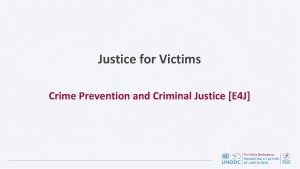Comparative Criminal Justice Systems Minorities Crime and Criminal























- Slides: 23

Comparative Criminal Justice Systems Minorities, Crime, and Criminal Justice: Spain, Britain, France, Netherlands - Europe Marshall

Spain q Population: 40 million q Member of the European Union q A democracy with a constitution (1978); constitution prohibits racial ethnic discrimination. q Two national police forces: the National Police and the Civil Guard q Mixed inquisitorial and adversarial criminal procedure q Minority Issue: Gypsies q Border Issue: Morocco – drugs and migrant labor

Gypsy and Payo Culture (Major Issues) n Culture differences n Gypsy law (oral tradition) and payo law (Spanish Law) n Police, court, and prison statistics do not report racial or ethnic variables* n Stereotype n Marginalization n Victimization * Qualitative interviews suggest that criminal justice professionals and gypsy leaders agree that gypsies are disproportionately represented in police arrests, court hearings, and prison populations.

Spain – Morocco Border

Immigration and the Spanish – Moroccan Border n Spain – Straight of Gibraltar – Morocco; a ten mile strait of confrontation (compared to the U. S. – Rio Grande – Mexico) n Spanish cities of Ceuta and Melilla on the northern Moroccan coast (fortified). The only EU country with an African border. n Smuggling Issues: Drugs and migrant labor (an entry point for migrants from Morocco, central Africa, the Philippines, and South America – Peru and Argentina). n Schengen Agreement regarding open borders within the EU has pressured Spain to enforce stricter visa policies, thus forcing more clandestine operations.

Major Issues – Immigration Spain n Disproportionate Involvement in Criminal Justice System: Legal or illegal immigrants total approximately 2% of the Spanish population. Foreigners in Spain represent approximately 8. 5% of total population arrested; 5. 5% convicted; and 16% incarcerated. n Increasing victimization: xenophobic assaults; illegal employment contracts and working conditions. n Concerns of immigrants: Marginalization, poor socioeconomic conditions, severance of social bonds, increasing hostility encountered in host country, deportation as punishment (legal or illegal immigrants).

Europe

Britain q Population: 60 million q Member of the European Union q A democracy with a constitution (1978); constitution prohibits racial ethnic discrimination. q Adversarial criminal procedure q Minority Population: Asians (Pakistani, Bangladeshi, and Indians); blacks (Caribbean or African origin); and Chinese. Historically made up of minorities from countries of the former British Empire.

Prison Statistics Britain n Black suspects and offenders appear to be disproportionately more likely to be brought into the criminal justice process and less likely to be filtered out. Asians follow a similar trend. n Asian and black offenders receive longer prison sentences (even when type of court, age of offender, and type of offence is considered). n Prison statistics (1995) show that the male prison population was 83% white; 11% black; 3% Asian; 3% Chinese/other. The female prison population was 76% white; 20% black; 1% Asian; and 4% Chinese/other.

Major Sentencing Issues Britain n Blacks are less likely to be cautioned than whites and Asians are more likely to be cautioned. n Blacks are more likely to be charged with “indictable only” offenses, i. e. , robbery. Therefore, they have a higher proportion to go to the Crown Court. n Blacks are more likely to be remanded in custody before trial. n Black people have a higher acquittal rate; however, if they are found guilty after they plead not guilty – they are liable to heavier penalties.

Britain: Victimization is disproportionate among ethnic minorities. Major Issues: q Age profile q Socioeconomic position q Geographical distribution q Racial hostility

Netherlands n Population: 16 million n Member of the European Union n Continental Welfare State: Low labor participation and high welfare dependency. n Three waves of immigrants due to decolonization, migrant workers, and refugees and asylum seekers (1950 s-1970 s). n Ethnic Minority Population (Approximately 10% of population): Surinamese (1. 7% - Dutch Guinea), Turkish (1. 6%), Moroccan (1. 3%), and Caribbean (0. 6% - Antilles), and immigrants from nonindustrialized nations and gypsies (. 9%).

Netherlands: Criminal Involvement n After 1974, ethnic backgrounds for arrest are no longer recorded. n Prison Population (1994): 50% white Dutch, 11% Surinamese, 8% Moroccan, 5% Turkish, 7% Antillian, and 5 % from various other European countries (most are legal residents). Thirteen percent are from non-European countries (Africa, Latin America, and the Middle East – illegal immigrants).

Netherlands: Organized Crime n Organized crime in the form of drug trade is ethnically controlled. n Heroin – Turks (Near East and Southeast Asia), hashish – Moroccans (North Africa and Pakistan), and cocaine – Surinamese (South America). n Due to intercontinental transportation and banking, the drug trade is organized primarily through the countries of origin. Thus, the drugs are brought into the Netherlands and subsequently, as a main port in shipping, the drugs are transported to other places in Europe and the rest of the world. The profits, in contrast to the U. S. , disappear back to the country of origin where money laundering and confiscation laws are not enforced.

Netherlands: Major Issues n Disproportionate involvement of ethnic minorities in crime. n Studies show bias and selectivity in policing. n First offenders who belong to ethnic minorities were more severely sentenced than white Dutch offenders. n Differential treatment of ethnic minorities, within the parameters of criminal procedure, is related to social and economic deprivation. n The open border policy has created more extensive policing, extradition, fining of employers of unlicensed workers, and exclusion of foreigners from public services.

France n Population: 60 million n Member of European Union n Inquisitorial criminal procedure n Two national police forces: the National Police Force and the National Gendarmerie n Minority Population (etrangers – non-French citizens living in France): Algeria, Morocco, Tunisians, Turks, Sub-Saharan Africans. n Minority Issues: “Etrangers” are overwhelmingly Muslim in contrast to the white, largely Catholic native French. Culture conflict and high unemployment – dualization of French society.

France: Criminal Justice Response n The rate of pretrial detention and provisional detention (punishment without the determination of guilt) is extremely high among etrangers. The reason: “it is indispensable for maintaining public order. ” n Etrangers are overrepresented in the prison population – approximately 30% of the total prison population. n Etrangers in general serve longer terms of incarceration.

France: Major Issues n Xenophobia and racism. n Dualization of French society – social and spatial segregation. n High unemployment, especially among etranger youth. n Transition from an industrial society to a modern postindustrial society. n Police resentment of judicial system. Police officer’s role in a dual society.

United States – Europe More Similar Than Different n Both are taking increasingly restrictive measures to deal with minorities and migrants. n Both have an increased focus on the control of immigration and cross-border crime. n Both often embrace the “minority-crime” connection. n Major difference: Most European countries object to ethnic monitoring and the systematic collection of information about nationality, citizenship, race, or ethnic background.

United States – Europe Victimization n Victimization studies show that immigrants and minorities are more likely to be victims of crime – in particular, violent crime. n Victim surveys show that criminal victimization to a large degree is intraethnic and intraracial (Exceptions include robbery in the U. S. and hate crime in both the U. S. and Europe)

United States – Europe Sentencing and Prison n In both Europe and the United States, conviction statistics show a higher representation of minorities for serious violent crime (homicide, robbery, rape) and for drug related crime. n There is a serious overrepresentation of minorities and foreigners in prison in both Europe and the U. S.

United States – Europe Major Issues for Minority Overrepresentation in Crime n Socioeconomic inequality n Deprivation (social position) n Marginality n Negative stereotyping n Disparity / Discrimination

United States – Europe Global Issues n In both Europe and the U. S. , the motives and composition of the recent immigrant population has changed. n Immigration reflects the push factors of religious and political persecution and poverty rather than the pull factor of the need for manpower. n Due to the global context of migration (motives and opportunities), the criminal involvement of first-generation immigrants is likely to increase in the near future.
 Guelph university criminal justice and public policy
Guelph university criminal justice and public policy What is corrections
What is corrections Unit 2 criminal law and juvenile justice
Unit 2 criminal law and juvenile justice What are the branches of criminal justice system
What are the branches of criminal justice system State of connecticut division of criminal justice
State of connecticut division of criminal justice The criminal justice funnel
The criminal justice funnel Grass eater vs meat eater police
Grass eater vs meat eater police Eighth amendment excessive bail
Eighth amendment excessive bail Consensus model criminal justice
Consensus model criminal justice Consensus model criminal justice
Consensus model criminal justice 4 pillars of justice
4 pillars of justice Consensus model criminal justice
Consensus model criminal justice Behavioral theory in criminal justice
Behavioral theory in criminal justice Consensus model criminal justice
Consensus model criminal justice Consensus model criminal justice
Consensus model criminal justice Consensus model criminal justice
Consensus model criminal justice Nonintervention perspective of criminal justice
Nonintervention perspective of criminal justice Funnel model of criminal justice
Funnel model of criminal justice Arizona criminal justice information system
Arizona criminal justice information system Responsibilities of saps in the criminal justice system
Responsibilities of saps in the criminal justice system Department of criminal justice services ny
Department of criminal justice services ny National archive of criminal justice data
National archive of criminal justice data Criminal justice wedding cake diagram
Criminal justice wedding cake diagram Criminal justice
Criminal justice









































